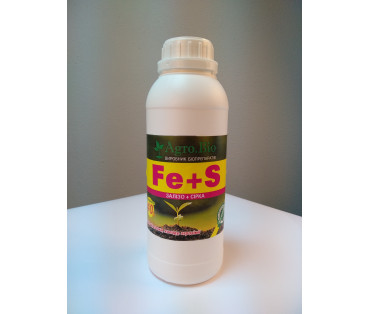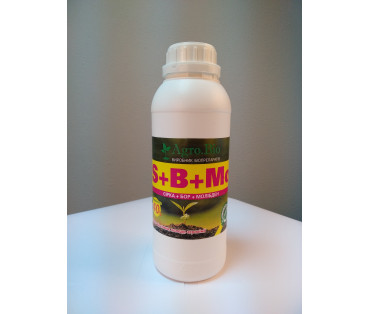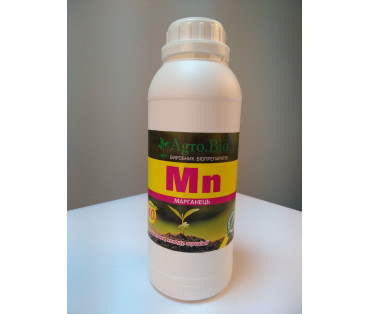Sulphur (S) on a level with phosphorus and nitrogen acts as an important factor in plant nutrition with major-nutrient element
Sulphur (S) on a level with phosphorus and nitrogen acts as an important factor in plant nutrition with major-nutrient element. Sulfur is a component of proteins, in particular the irreplaceable component of amino acids (cystine, cysteine, methionine) and phytohormones; is involved in metabolic processes such as protein biosynthesis, in redox processes, affects the functioning of the hydrolytic enzymes activity, the synthesis of carbohydrates; increases the intensity of assimilation; is involved in plant' cell fission, promotes the formation of chlorophyll iron-sulphur proteins electron transfer during photosynthesis; has positive effect on nodule bacteria formation during nitrogen fixation; helps to shape young leaf tissue, reproductive organs (including seeds); is a part of vitamins (theanine, biotin, B group), improves the nutrition with major- and minor nutrient elements (nitrogen, phosphorus, potassium, calcium, magnesium, boron, copper, zinc and molybdenum); increases plant resistance to pests, stress factors (drought, temperature changes) and affects crop yields.
In the soil sulphur is present in plant organic residues and humus (in this form, it is unavailable for plant organism); the sulfur transformation in the direction of mineralization with the participation of microorganisms is necessary, but this process in the soil environment passes too slowly, and the major part of sulfur is absorbed by the soil from the atmosphere (S02) and is available from precipitation. It is necessary to fertilize agricultural croppers with sulfates, which contain sulfur and are combined with other main substances most available to the plant (sulfur content 10-25% of the total quantity). Vegetable crops, especially tomatoes, onion, garlic, celery, various varieties of cabbage, rapeseed, sunflower, alfalfa, clover, peas, soybeans, potatoes, have quite significant need in this element; and fruit and berry woody plants and grain cultures need small amount of sulphur. Sulfur is not recommended to combine with silicon.
Sulphur deficiency:when the amount of sulfur is insufficient, a pale green color on the young leaves is formed (external characters are similar to nitrogenous nutrition deficiency (although with lack of nitrogen changes are observed on the old leaves)), after a while they turn yellow, acquire a red tint (anthocyanins are accumulated), and then die; the leaves of cabbage family plants become long, narrow; nightshade family (Solanaceae) plants have a small diameter of the stems that become lignified, hard); Asteraceae - the sunflower – forms small inflorescences, flower head has no flowering; the activity of nitrogen-assimilating nodule bacteria and the process of photosynthesis slow down in legumes. With insufficient amounts of sulfur in the soil, the growth and development of stems (they become thin, hard, fragile and lignified) are delayed, plant resistance to diseases, pests and stress factors decreases.
Sulphur interinfluence with other elements
| Antagonists (overbalance of one triggers a deficiency of another element) | Synergist (improve mutual properties of each other) | Block the each other interaction (it is not recommended to combine together) |
| Cl (chlorine) | - | - |
Related Products
Humate + Copper + Sulfur «Agro.Bio»
Copper is largely responsible for the formation of the generative organs of plants and the intensity of photosynthesis, strengthens the immune system and helps to increase the resistance of crops to l..
$9.00
Humate + Iron + Sulfur «Agro.Bio»
Iron (Fe) is an important element in plant life, which is responsible for the biosynthesis of chlorophyll. According to its (Fe) participation, redox processes, processes of respiration and photosynth..
$11.00
Humate + Zinc + Sulfur «Agro.Bio»
The biologically available form of Zn allows you to quickly restore the balance of this important trace element in case of its insufficient amount. Zinc is part of many enzymes that are responsible fo..
$9.00
Sulfur + Boron + Molybdenum «Agro.Bio»
In the soil, sulfur is present in plant organic residues and humus (in this form it is not available for the plant organism), it is necessary for the transformation of sulfur in the direction of miner..
$13.00
Humat + Manganese + Sulfur «Agro.Bio»
The preparation Humate + Manganese + Sulfur "Agrobio" combines the humate of potassium and Mn. This trace element is an active component of enzymes that are responsible for the processes of respiratio..
$12.00





